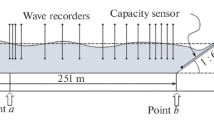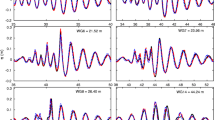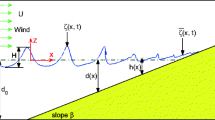Abstract
The modeling of wave-breaking dissipation in coastal areas is investigated with a fully nonlinear and dispersive wave model. The wave propagation model is based on potential flow theory, which initially assumes non-overturning waves. Including the impacts of wave-breaking dissipation is, however, possible by implementing a wave breaking initiation criterion and dissipation mechanism. Three criteria from the literature, including a geometric, kinematic, and dynamic-type criterion, are tested to determine the optimal criterion predicting the onset of wave breaking. Three wave-breaking energy dissipation methods are also tested: the first two are based on the analogy of a breaking wave with a hydraulic jump, and the third one applies an eddy viscosity dissipative term. Numerical simulations are performed using combinations of the three breaking onset criteria and three dissipation methods. The simulation results are compared to observations from four laboratory experiments of regular and irregular waves breaking over a submerged bar, irregular waves breaking on a beach, and irregular waves breaking over a submerged slope. The different breaking approaches provide similar results after proper calibration. The wave transformation observed in the experiments is reproduced well, with better results for the case of regular waves than irregular waves. Moreover, the wave statistics and wave spectra are predicted well in general, and in particular for regular waves. Some differences are observed for irregular wave cases, in particular in the low-frequency range. This is attributed to incomplete absorption of the long waves in the numerical model. Otherwise, the wave spectra in the range \([0.5f_{\text {p}},\, 5f_{\text {p}}]\) are reproduced well before, within, and after the breaking zone for the three irregular wave experiments.














Similar content being viewed by others
References
Adytia D, Husrin S (2018) Numerical simulation of breaking regular and irregular wave propagation above a sloping bottom. J Phys Conf Ser 1090:012065
Athanassoulis GA, Papoutsellis CE (2017) Exact semi-separation of variables in waveguides with non-planar boundaries. Proc R Soc A Math Phys Eng Sci 473(2201):20170017
Barthelemy X, Banner ML, Peirson WL, Fedele F, Allis M, Dias F (2018) On a unified breaking onset threshold for gravity waves in deep and intermediate depth water. J Fluid Mech 841:463–488
Beji S, Battjes J (1993) Experimental investigation of wave propagation over a bar. Coast Eng 19(1):151–162
Benoit M, Raoult C, Yates ML (2017) Analysis of the linear version of a highly dispersive potential water wave model using a spectral approach in the vertical. Wave Motion 74:159–181
Bingham HB, Zhang H (2007) On the accuracy of finite-difference solutions for nonlinear water waves. J Eng Math 58(1):211–228
Cienfuegos R, Barthélemy E, Bonneton P (2010) Wave-breaking model for Boussinesq-type equations including roller effects in the mass conservation equation. J Waterw Port Coast Ocean Eng 136(1):10–26
Craig W, Sulem C (1993) Numerical simulation of gravity waves. J Comput Phys 108(1):73–83
Dold J (1992) An efficient surface-integral algorithm applied to unsteady gravity waves. J Comput Phys 103(1):90–115
Dold J, Peregrine H (1986) An efficient boundary integral method for steep unsteady water waves. In: Morton KW, Baines MJ (eds) Numerical methods for fluid dynamics II, no. 7 in The Institute of Mathematics and Its Applications conference series, Oxford University Press, Oxford, pp 671–679
Dysthe KB (1979) Note on a modification to the nonlinear Schrodinger equation for application to deep water waves. Proc R Soc A Math Phys Eng Sci 369(1736):105–114
Engsig-Karup A, Eskilsson C, Bigoni D (2016) A stabilised nodal spectral element method for fully nonlinear water waves. J Comput Phys 318:1–21
Fructus D, Clamond D, Grue J, Kristiansen Ø (2005) An efficient model for three-dimensional surface wave simulations. Part I: free space problems. J Comput Phys 205(2):665–685
Gottlieb S (2005) On high order strong stability preserving Runge–Kutta and multi step time discretizations. J Sci Comput 25(1):105–128
Gouin M, Ducrozet G, Ferrant P (2016) Development and validation of a non-linear spectral model for water waves over variable depth. Eur J Mech B Fluids 57:115–128
Grilli S, Skourup J, Svendsen I (1989) An efficient boundary element method for nonlinear water waves. Eng Anal Bound Elem 6(2):97–107
Grilli ST, Horrillo J, Guignard S (2019) Fully nonlinear potential flow simulations of wave shoaling over slopes: spilling breaker model and integral wave properties. Water Waves. https://doi.org/10.1007/s42286-019-00017-6
Guignard S, Grilli ST (2001) Modeling of wave shoaling in a 2D-NWT using a spilling breaker model. In: ISOPE-I-01-253, International Society of Offshore and Polar Engineers, ISOPE, Stavanger, Norway. pp. 8
Hasan S, Sriram V, Selvam RP (2019) Evaluation of an eddy viscosity type wave breaking model for intermediate water depths. Eur J Mech B Fluids 78:115–138
Husrin S, Strusińska A, Oumeraci H (2012) Experimental study on tsunami attenuation by mangrove forest. Earth Planets Space 64(10):15
Kazolea M, Delis A, Synolakis C (2014) Numerical treatment of wave breaking on unstructured finite volume approximations for extended Boussinesq-type equations. J Comput Phys 271:281–305
Kennedy AB, Chen Q, Kirby JT, Dalrymple RA (2000) Boussinesq modeling of wave transformation, breaking, and runup. I: 1D. J Waterw Port Coast Ocean Eng 126(1):39–47
Kharif C, Pelinovsky E (2003) Physical mechanisms of the rogue wave phenomenon. Eur J Mech B Fluids 22(6):603–634
Kurnia R, van Groesen E (2014) High order Hamiltonian water wave models with wave-breaking mechanism. Coast Eng 93:55–70
Lamb H (1932) Hydrodynamics, 6th edn. University Press, Cambridge
Longuet-Higgins MS, Cokelet ED (1976) The deformation of steep surface waves on water—I. A numerical method of computation. Proc R Soc Lond A Math Phys Sci 350(1660):1–26
Ma Q, Yan S (2006) Quasi ALE finite element method for nonlinear water waves. J Comput Phys 212(1):52–72
Mase H, Kirby JT (1992) Hybrid frequency-domain KdV equation for random wave transformation. In: Coastal Engineering Proceedings, Venice, Italy, 23rd International Conference on Coastal Engineering, pp 474–487
Okamoto T, Basco DR (2006) The Relative Trough Froude Number for initiation of wave breaking: theory, experiments and numerical model confirmation. Coast Eng 53(8):675–690
Papoutsellis CE, Charalampopoulos A, Athanassoulis G (2018a) Implementation of a fully nonlinear Hamiltonian Coupled-Mode Theory, and application to solitary wave problems over bathymetry. Eur J Mech B Fluids 72:199–224
Papoutsellis CE, Yates ML, Simon B, Benoit M (2018b) Fully nonlinear modeling of nearshore wave propagation including the effects of wave breaking. Coast Eng Proc 1(36):78. https://doi.org/10.9753/icce.v36.waves.78
Papoutsellis CE, Yates ML, Simon B, Benoit M (2019) Modeling of depth-induced wave breaking in a fully nonlinear free-surface potential flow model. Coast Eng 154:103579
Raoult C, Benoit M, Yates ML (2016) Validation of a fully nonlinear and dispersive wave model with laboratory non-breaking experiments. Coast Eng 114:194–207
Saket A, Peirson WL, Banner ML, Barthelemy X, Allis MJ (2017) On the threshold for wave breaking of two-dimensional deep water wave groups in the absence and presence of wind. J Fluid Mech 811:642–658
Schäffer HA, Madsen PA, Deigaard R (1993) A Boussinesq model for waves breaking in shallow water. Coast Eng 20(3):185–202
Simon B, Papoutsellis CE, Benoit M, Yates ML (2018) Modeling of depth-induced wave breaking in a simulation code for nonlinear and dispersive waves in the coastal zone. In: Proceedings of 16èmes Journées de l’Hydrodynamique, 27–29 November 2018, Marseille, France
Stansell P, MacFarlane C (2002) Experimental investigation of wave breaking criteria based on wave phase speeds. J Phys Oceanogr 32(5):1269–1283
Svendsen IA, Madsen PA, Hansen JB (1978) Wave characteristics in the surf zone. In: International conference on coastal engineering 1978. American Society of Civil Engineers, Hamburg, Germany, pp 520–539
Tian Y, Sato S (2008) A numerical model on the interaction between nearshore nonlinear waves and strong currents. Coast Eng J 50(4):369–395
Wang J, Ma QW (2015) Numerical techniques on improving computational efficiency of spectral boundary integral method. Int J Numer Methods Eng 102(10):1638–1669
Wu G, Eatock Taylor R (1994) Finite element analysis of two-dimensional non-linear transient water waves. Appl Ocean Res 16(6):363–372
Yates ML, Benoit M (2015) Accuracy and efficiency of two numerical methods of solving the potential flow problem for highly nonlinear and dispersive water waves. Int J Numer Methods Fluids 77(10):616–640
Zakharov VE (1968) Stability of periodic waves of finite amplitude on the surface of a deep fluid. J Appl Mech Tech Phys 9(2):190–194
Acknowledgements
The authors thank Prof. S. Beji for providing the laboratory data for waves breaking over the bar, Prof. J. T. Kirby for providing the laboratory data of irregular waves breaking on the beach and Dr. S. Husrin for providing laboratory data of irregular waves breaking on the submerged slope. This work was carried out in the framework of the DEPHYMAN project. It has received funding from Excellence Initiative of Aix-Marseille University - A*MIDEX, a French “Investissements d’Avenir” programme with reference ANR-11-IDEX-0001-02. It has been carried out in the framework of the Labex MEC (Mécanique et Complexité), with reference ANR-10-LABX-0092. C. Papoutsellis, M. Benoit and M. Yates also acknowledge support from the DiMe project, which benefits from French Government support managed by the ANR under the program “Investissements d’Avenir” with the reference ANR-10-IEED-0006-14.
Author information
Authors and Affiliations
Corresponding author
Additional information
Publisher's Note
Springer Nature remains neutral with regard to jurisdictional claims in published maps and institutional affiliations.
Rights and permissions
About this article
Cite this article
Simon, B., Papoutsellis, C.E., Benoit, M. et al. Comparing methods of modeling depth-induced breaking of irregular waves with a fully nonlinear potential flow approach. J. Ocean Eng. Mar. Energy 5, 365–383 (2019). https://doi.org/10.1007/s40722-019-00154-7
Received:
Accepted:
Published:
Issue Date:
DOI: https://doi.org/10.1007/s40722-019-00154-7




